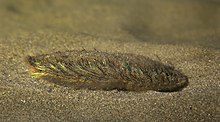Aphrodita is a genus of marine polychaete worms found in the Mediterranean Sea and the Atlantic Ocean.[2]
| Aphrodita | |
|---|---|

| |
| Aphrodita aculeata | |
| Scientific classification | |
| Domain: | Eukaryota |
| Kingdom: | Animalia |
| Phylum: | Annelida |
| Clade: | Pleistoannelida |
| Subclass: | Errantia |
| Order: | Phyllodocida |
| Suborder: | Aphroditiformia |
| Family: | Aphroditidae |
| Genus: | Aphrodita Linnaeus, 1758[1] |
| Type species | |
| Aphrodita aculeata Linnaeus, 1758
| |
| Species | |
|
See text | |
Several members of the genus are known as "sea mice".
Etymology
editThe name of the genus is taken from Aphrodite, the Ancient Greek goddess of love, said to be because of a resemblance to human female genitalia.[3] The English name may derive from the animal's similarity, when washed up on shore, to a bedraggled house mouse.[4]
Description
editAphrodita adults generally fall within a size range of 7.5 to 15 centimetres (3.0 to 5.9 in), with some growing to 30 centimetres (12 in). The body is covered in a dense mat of parapodia and setae (hairlike structures).[2] The animal lacks eyes, feeling its way with two pairs of appendages close to the mouth. Several small, bristly, paddle-like appendages provide locomotion. Aphrodita are hermaphroditic, having functional reproductive organs of both sexes, with the eggs of one individual being fertilised by the sperm of another.[5]
Structural coloration
editThe spines, or setae[2] on the back of the animal are a unique feature. Normally, these have a deep red sheen. But when light shines on them perpendicularly, they flush green and blue – a "remarkable example of photonic engineering by a living organism". This structural coloration is a defense mechanism, giving a warning signal to potential predators. The effect is produced by many hexagonal cylinders within the spines, which are said to perform much more efficiently than man-made optical fibres.[6]
Feeding
editAphrodita are typically scavengers.[2] However, Aphrodita aculeata is an active predator,[7] feeding primarily on small crabs, hermit crabs, and other polychaete worms such as Pectinaria.[7]
Species
editSpecies recognized by the World Register of Marine Species:[1]
- Aphrodita abyssalis Kirkegaard, 1996
- Aphrodita aculeata Linnaeus, 1758
- Aphrodita acuminata Ehlers, 1887
- Aphrodita alta Kinberg, 1856
- Aphrodita annulata Pennant, 1777
- Aphrodita aphroditoides (McIntosh, 1885)
- Aphrodita armifera Moore, 1910
- Aphrodita audouini Castelnau, 1842<'small>
- Aphrodita australis Baird, 1865
- Aphrodita bamarookis Hutchings & McRae, 1993
- Aphrodita bisetosa Rozbaczylo & Canahuire, 2000
- Aphrodita brevitentaculata Essenberg, 1917
- Aphrodita californica Essenberg, 1917
- Aphrodita clavigera Freminville, 1812
- Aphrodita daiyumaruae Imajima, 2005
- Aphrodita decipiens (Horst, 1916)
- Aphrodita defendens Chamberlin, 1919
- Aphrodita diplops Fauchald, 1977
- Aphrodita echidna Quatrefages, 1866
- Aphrodita elliptica
- Aphrodita falcifera Hartman, 1939
- Aphrodita goolmarris Hutchings & McRae, 1993
- Aphrodita hoptakero Otto in Audouin & Milne Edwards, 1832
- Aphrodita japonica Marenzeller, 1879
- Aphrodita kulmaris Hutchings & McRae, 1993
- Aphrodita limosa (Horst, 1916)
- Aphrodita longicornis Kinberg, 1855
- Aphrodita longipalpa Essenberg, 1917
- Aphrodita macroculata Imajima, 2001
- Aphrodita magellanica Malard, 1891
- Aphrodita malayana (Horst, 1916)
- Aphrodita malkaris Hutchings & McRae, 1993
- Aphrodita maorica Benham, 1900
- Aphrodita marombis Hutchings & McRae, 1993
- Aphrodita mexicana Kudenov, 1975
- Aphrodita modesta Quatrefages, 1866
- Aphrodita negligens Moore, 1905
- Aphrodita nipponensis Imajima, 2003
- Aphrodita obtecta Ehlers, 1887
- Aphrodita parva Moore, 1905
- Aphrodita perarmata Roule, 1898
- Aphrodita refulgida Moore, 1910
- Aphrodita rossi Knox & Cameron, 1998
- Aphrodita roulei Horst, 1917
- Aphrodita scolopendra Bruguière, 1789
- Aphrodita sericea Castelnau, 1842
- Aphrodita sibogae (Horst, 1916)
- Aphrodita sondaica Grube, 1875
- Aphrodita sonorae Kudenov, 1975
- Aphrodita talpa Quatrefages, 1866
- Aphrodita terraereginae Haswell, 1883
- Aphrodita tosaensis Imajima, 2001
- Aphrodita watasei Izuka, 1912
References
edit- ^ a b Fauchald, Kristian; Bellan, Gérard (2008). "Aphrodita Linnaeus, 1758". World Polychaeta database. World Register of Marine Species. Retrieved 28 July 2016.
- ^ a b c d "sea mouse". Encyclopædia Britannica. Encyclopædia Britannica, Inc. Retrieved April 26, 2012.
- ^ Kennedy, Jennifer (1 October 2019). "Profile of the Sea Mouse Ocean Worm". ThoughtCo. Retrieved 29 September 2021.
- ^ Warren, Rebecca; van Zyl, Miezan; O'Rourke, Ruth; Tokeley, Amber; Heilman, Christine, eds. (2006). "Ocean Life". Ocean: The World's Last Wilderness Revealed (first American ed.). New York City: DK Publishing. p. 276. ISBN 978-0-7566-2205-3.
- ^ "Sea Mouse". Encyclopaedia Britannica.
- ^ "Sea mouse promises bright future". BBC News. BBC. January 3, 2001. Retrieved April 26, 2012.
- ^ a b Tyler, Lizzie. "BIOTIC Species Information for Aphrodita aculeata". Biological Traits Information Catalogue. Retrieved 24 December 2014.